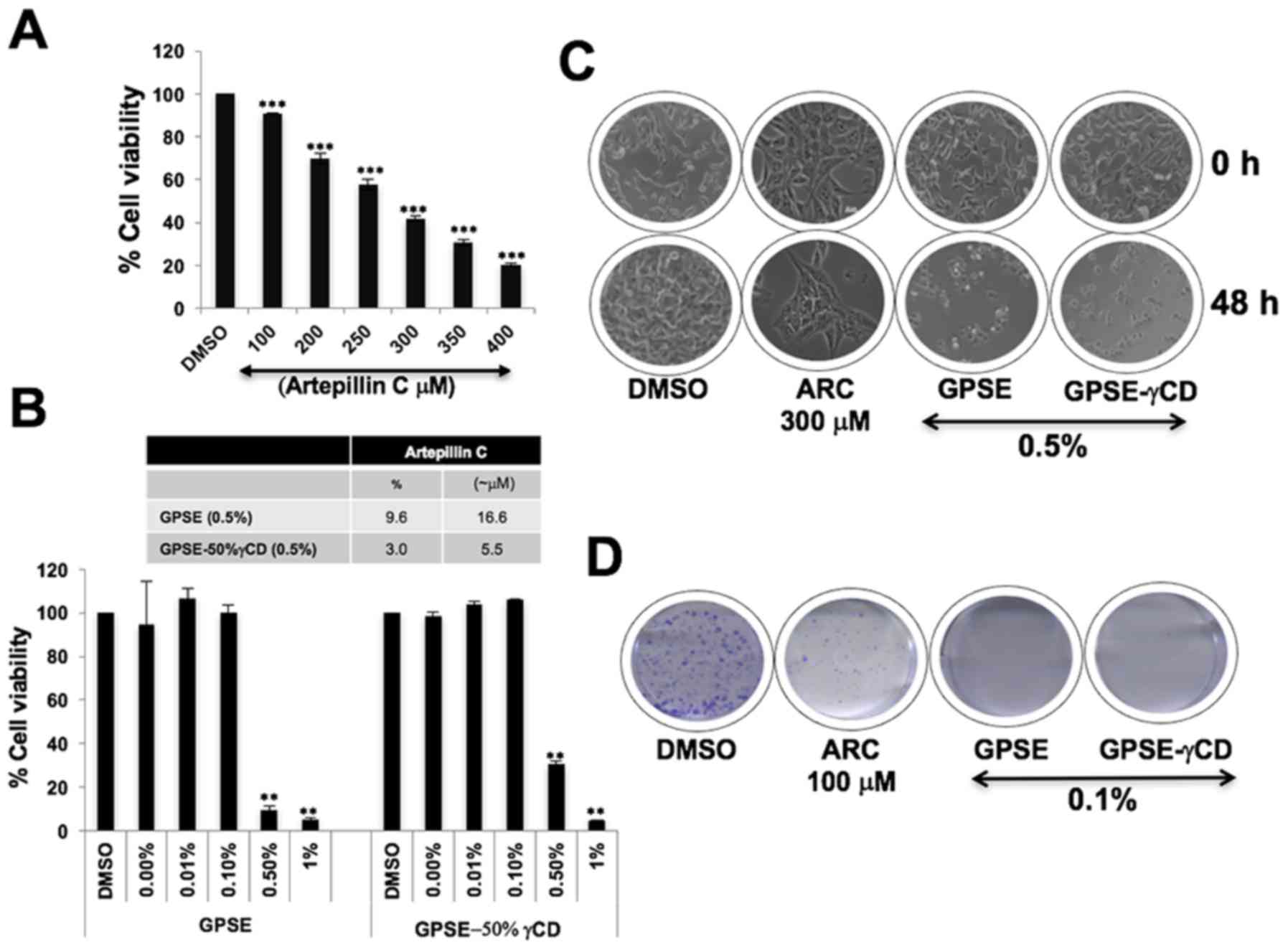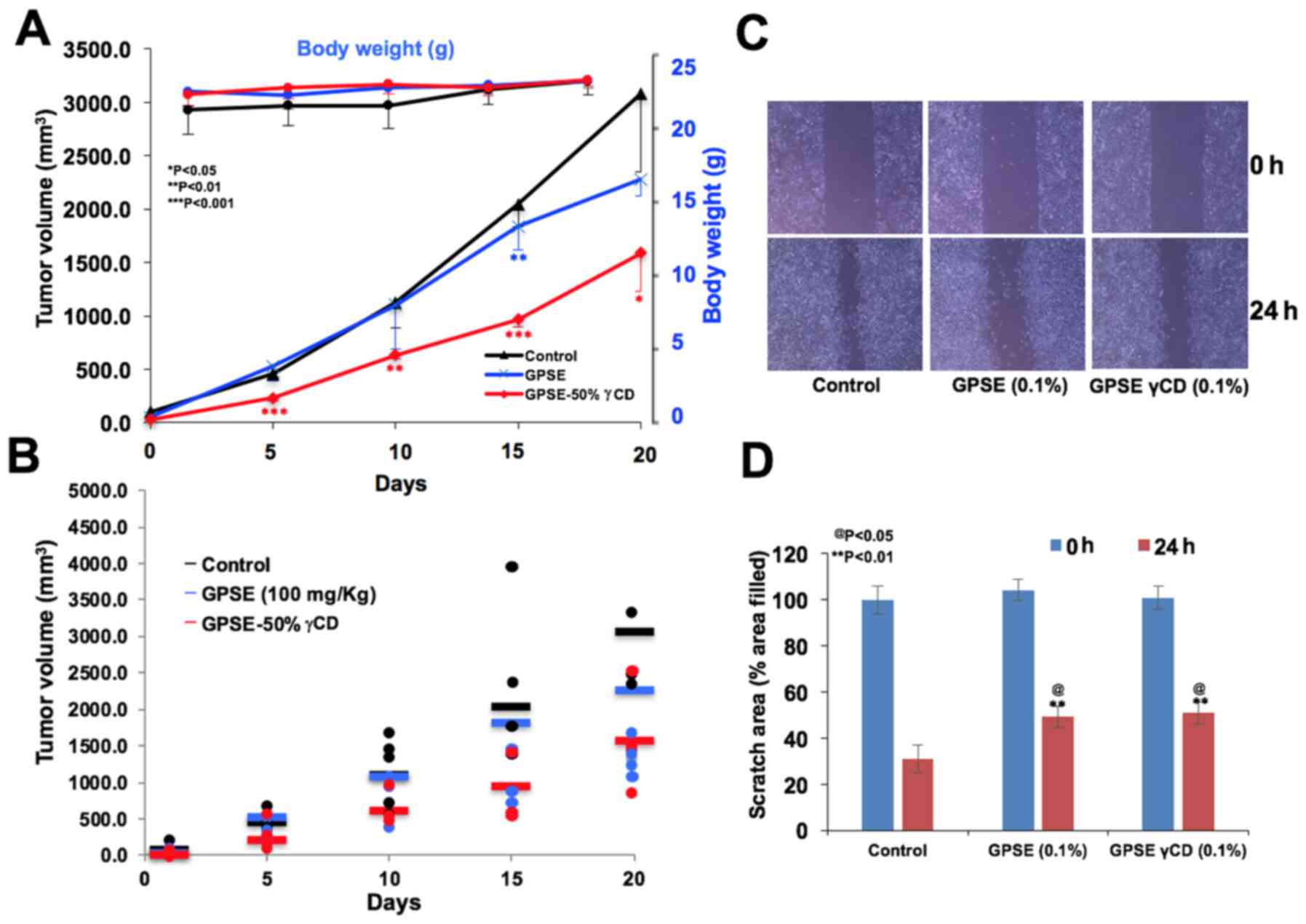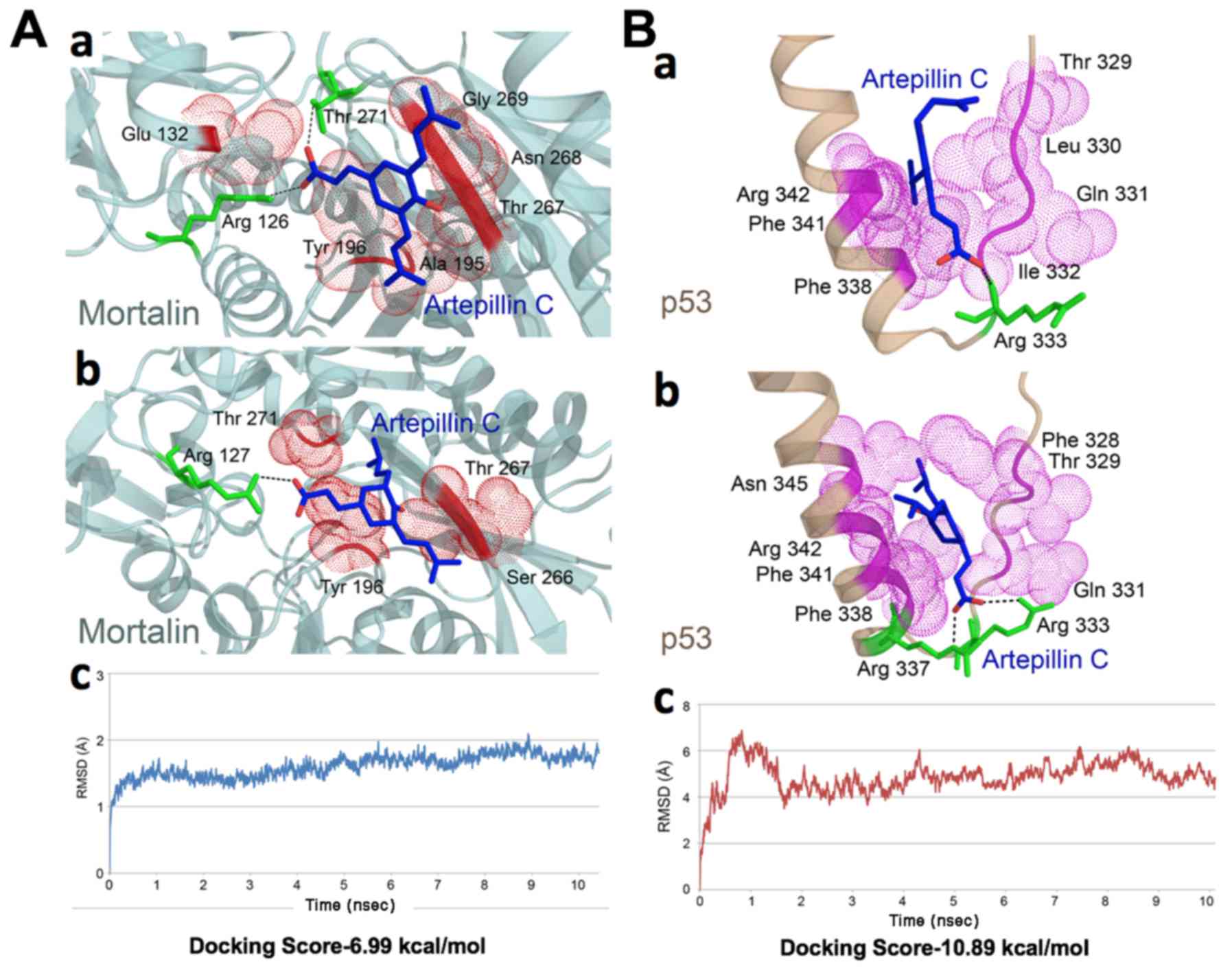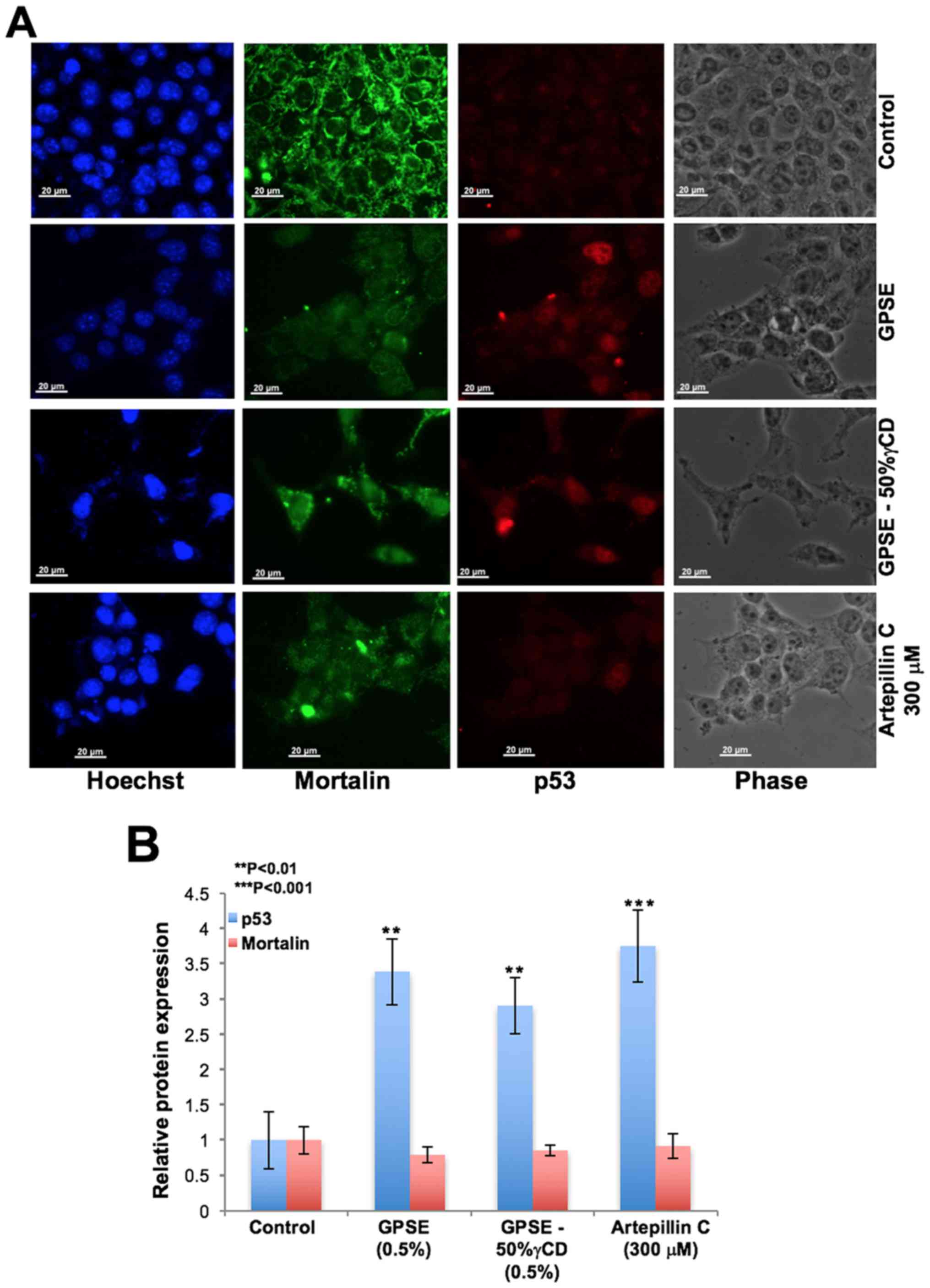|
1
|
Bankova V: Chemical diversity of propolis
and the problem of standardization. J Ethnopharmacol. 100:114–117.
2005. View Article : Google Scholar : PubMed/NCBI
|
|
2
|
Kuropatnicki AK, Szliszka E and Krol W:
Historical aspects of propolis research in modern times. Evid Based
Complement Alternat Med. 2013:9641492013. View Article : Google Scholar : PubMed/NCBI
|
|
3
|
Burdock GA: Review of the biological
properties and toxicity of bee propolis (propolis). Food Chem
Toxicol. 36:347–363. 1998. View Article : Google Scholar : PubMed/NCBI
|
|
4
|
Bankova V, Popova M and Trusheva B:
Propolis volatile compounds: chemical diversity and biological
activity: A review. Chem Cent J. 8:282014. View Article : Google Scholar : PubMed/NCBI
|
|
5
|
Fauzi AN, Norazmi MN and Yaacob NS:
Tualang honey induces apoptosis and disrupts the mitochondrial
membrane potential of human breast and cervical cancer cell lines.
Food Chem Toxicol. 49:871–878. 2011. View Article : Google Scholar
|
|
6
|
Ghashm AA, Othman NH, Khattak MN, Ismail
NM and Saini R: Antiproliferative effect of Tualang honey on oral
squamous cell carcinoma and osteosarcoma cell lines. BMC Complement
Altern Med. 10:492010. View Article : Google Scholar : PubMed/NCBI
|
|
7
|
Khacha-ananda S, Tragoolpua K,
Chantawannakul P and Tragoolpua Y: Antioxidant and anti-cancer cell
proliferation activity of propolis extracts from two extraction
methods. Asian Pac J Cancer Prev. 14:6991–6995. 2013. View Article : Google Scholar
|
|
8
|
Machado BA, Silva RP, Barreto GA, Costa
SS, Silva DF, Brandão HN, Rocha JL, Dellagostin OA, Henriques JA,
Umsza-Guez MA, et al: Chemical composition and biological activity
of extracts obtained by supercritical extraction and ethanolic
extraction of brown, green and red propolis derived from different
geographic regions in Brazil. PLoS One. 11:e01459542016. View Article : Google Scholar : PubMed/NCBI
|
|
9
|
Messerli SM, Ahn MR, Kunimasa K,
Yanagihara M, Tatefuji T, Hashimoto K, Mautner V, Uto Y, Hori H,
Kumazawa S, et al: Artepillin C (ARC) in Brazilian green propolis
selectively blocks oncogenic PAK1 signaling and suppresses the
growth of NF tumors in mice. Phytother Res. 23:423–427. 2009.
View Article : Google Scholar
|
|
10
|
Rao CV, Desai D, Simi B, Kulkarni N, Amin
S and Reddy BS: Inhibitory effect of caffeic acid esters on
azoxymethane-induced biochemical changes and aberrant crypt foci
formation in rat colon. Cancer Res. 53:4182–4188. 1993.PubMed/NCBI
|
|
11
|
Sawicka D, Car H, Borawska MH and
Nikliński J: The anticancer activity of propolis. Folia Histochem
Cytobiol. 50:25–37. 2012. View Article : Google Scholar : PubMed/NCBI
|
|
12
|
Wadhwa R, Nigam N, Bhargava P, Dhanjal JK,
Goyal S, Grover A, Sundar D, Ishida Y, Terao K and Kaul SC:
Molecular characterization and enhancement of anticancer activity
of caffeic acid phenethyl ester by γ cyclodextrin. J Cancer.
7:1755–1771. 2016. View Article : Google Scholar :
|
|
13
|
Gao W, Wu J, Wei J, Pu L, Guo C, Yang J,
Yang M and Luo H: Brazilian green propolis improves immune function
in aged mice. J Clin Biochem Nutr. 55:7–10. 2014. View Article : Google Scholar : PubMed/NCBI
|
|
14
|
Khayyal MT, el-Ghazaly MA and el-Khatib
AS: Mechanisms involved in the antiinflammatory effect of propolis
extract. Drugs Exp Clin Res. 19:197–203. 1993.PubMed/NCBI
|
|
15
|
Wang L, Yang L, Debidda M, Witte D and
Zheng Y: Cdc42 GTPase-activating protein deficiency promotes
genomic instability and premature aging-like phenotypes. Proc Natl
Acad Sci USA. 104:1248–1253. 2007. View Article : Google Scholar : PubMed/NCBI
|
|
16
|
Kujumgiev A, Tsvetkova I, Serkedjieva Y,
Bankova V, Christov R and Popov S: Antibacterial, antifungal and
antiviral activity of propolis of different geographic origin. J
Ethnopharmacol. 64:235–240. 1999. View Article : Google Scholar : PubMed/NCBI
|
|
17
|
Pepeljnjak S, Jalsenjak I and Maysinger D:
Flavonoid content in propolis extracts and growth inhibition of
Bacillus subtilis. Pharmazie. 40:122–123. 1985.PubMed/NCBI
|
|
18
|
Velikova M, Bankova V, Tsvetkova I,
Kujumgiev A and Marcucci MC: Antibacterial ent-kaurene from
Brazilian propolis of native stingless bees. Fitoterapia.
71:693–696. 2000. View Article : Google Scholar : PubMed/NCBI
|
|
19
|
Jafarzadeh Kashi TS, Kasra Kermanshahi R,
Erfan M, Vahid Dastjerdi E, Rezaei Y and Tabatabaei FS: Evaluating
the in vitro antibacterial effect of Iranian propolis on oral
microorganisms. Iran J Pharm Res. 10:363–368. 2011.PubMed/NCBI
|
|
20
|
Sartori G, Pesarico AP, Pinton S,
Dobrachinski F, Roman SS, Pauletto F, Rodrigues LC Jr and Prigol M:
Protective effect of brown Brazilian propolis against acute vaginal
lesions caused by herpes simplex virus type 2 in mice: Involvement
of antioxidant and anti-inflammatory mechanisms. Cell Biochem
Funct. 30:1–10. 2012. View
Article : Google Scholar
|
|
21
|
Choudhari MK, Haghniaz R, Rajwade JM and
Paknikar KM: Anticancer activity of Indian stingless bee propolis:
An in vitro study. Evid Based Complement Alternat Med.
2013.928280:2013.
|
|
22
|
Benguedouar L, Boussenane HN, Wided K,
Alyane M, Rouibah H and Lahouel M: Efficiency of propolis extract
against mitochondrial stress induced by antineoplasic agents
(doxorubicin and vinblastin) in rats. Indian J Exp Biol.
46:112–119. 2008.PubMed/NCBI
|
|
23
|
Chen CN, Weng MS, Wu CL and Lin JK:
Comparison of radical scavenging activity, cytotoxic effects and
apoptosis induction in human melanoma cells by Taiwanese propolis
from different sources. Evid Based Complement. Alternat Med.
1:175–185. 2004.
|
|
24
|
Hirokawa Y, Levitzki A, Lessene G, Baell
J, Xiao Y, Zhu H and Maruta H: Signal therapy of human pancreatic
cancer and NF1-deficient breast cancer xenograft in mice by a
combination of PP1 and GL-2003, anti-PAK1 drugs (Tyr-kinase
inhibitors). Cancer Lett. 245:242–251. 2007. View Article : Google Scholar
|
|
25
|
Maruta H: Effective neurofibromatosis
therapeutics blocking the oncogenic kinase PAK1. Drug Discov Ther.
5:266–278. 2011. View Article : Google Scholar
|
|
26
|
Veiga RS, De Mendonça S, Mendes PB,
Paulino N, Mimica MJ, Lagareiro Netto AA, Lira IS, López BG, Negrão
V and Marcucci MC: Artepillin C and phenolic compounds responsible
for antimicrobial and antioxidant activity of green propolis and
Baccharis dracunculifolia DC. J Appl Microbiol. 122:911–920. 2017.
View Article : Google Scholar : PubMed/NCBI
|
|
27
|
Kimoto T, Arai S, Kohguchi M, Aga M,
Nomura Y, Micallef MJ, Kurimoto M and Mito K: Apoptosis and
suppression of tumor growth by artepillin C extracted from
Brazilian propolis. Cancer Detect Prev. 22:506–515. 1998.
View Article : Google Scholar : PubMed/NCBI
|
|
28
|
Matsuno T, Jung SK, Matsumoto Y, Saito M
and Morikawa J: Preferential cytotoxicity to tumor cells of
3,5-diprenyl-4-hydroxycinnamic acid (artepillin C) isolated from
propolis. Anticancer Res. 17A:3565–3568. 1997.
|
|
29
|
Konishi Y, Hitomi Y, Yoshida M and
Yoshioka E: Absorption and bioavailability of artepillin C in rats
after oral administration. J Agric Food Chem. 53:9928–9933. 2005.
View Article : Google Scholar : PubMed/NCBI
|
|
30
|
Konishi Y: Transepithelial transport of
artepillin C in intestinal Caco-2 cell monolayers. Biochim Biophys
Acta. 1713:138–144. 2005. View Article : Google Scholar : PubMed/NCBI
|
|
31
|
Berman HM, Battistuz T, Bhat TN, Bluhm WF,
Bourne PE, Burkhardt K, Feng Z, Gilliland GL, Iype L, Jain S, et
al: The Protein Data Bank. Acta Crystallogr D Biol Crystallogr.
58:899–907. 2002. View Article : Google Scholar : PubMed/NCBI
|
|
32
|
Bolton EE, Wang Y, Thiessen PA and Bryant
SH: Chapter 12-PubChem: Integrated platform of small molecules and
biological activities. Annu Rep Comput Chem. 4:217–241. 2008.
View Article : Google Scholar
|
|
33
|
Van Der Spoel D, Lindahl E, Hess B,
Groenhof G, Mark AE and Berendsen HJ: GROMACS: Fast, flexible, and
free. J Comput Chem. 26:1701–1718. 2005. View Article : Google Scholar : PubMed/NCBI
|
|
34
|
van der Spoel D, van Maaren PJ and Caleman
C: GROMACS molecule & liquid database. Bioinformatics.
28:752–753. 2012. View Article : Google Scholar : PubMed/NCBI
|
|
35
|
Lindorff-Larsen K, Piana S, Palmo K,
Maragakis P, Klepeis JL, Dror RO and Shaw DE: Improved side-chain
torsion potentials for the Amber ff99SB protein force field.
Proteins. 78:1950–1958. 2010.PubMed/NCBI
|
|
36
|
van der Spoel D, Lindahl E, Hess B, Van
Buuren AR, Apol E, Meulenhoff PJ, Tieleman DP, Sijbers ALTM,
Feenstra KA, van Drunen R, et al: GROMACS user manual version 3.3.
2008, http://ftp.gromacs.org/pub/manual/manual-3.3.pdfurisimpleftp://ftp.gromacs.org/pub/manual/manual-3.3.pdf.
|
|
37
|
van Gunsteren W, Billeter S, Eising A,
Hünenberger P, Krüger P, Mark A, Scott W and Tironi I: Gromos43a1.
Hochschulverlag AG an der ETH Zürich; Zürich: 1996
|
|
38
|
Nobushi Y, Oikawa N, Okazaki Y, Tsutsumi
S, Park YK, Kurokawa M and Yasukawa K: Determination of
Artepillin-C in Brazilian propolis by HPLC with photodiode array
detector. J Pharm Nutr Sci. 2:127–131. 2012.
|
|
39
|
Ryu J, Kaul Z, Yoon AR, Liu Y, Yaguchi T,
Na Y, Ahn HM, Gao R, Choi IK, Yun CO, et al: Identification and
functional characterization of nuclear mortalin in human
carcinogenesis. J Biol Chem. 289:24832–24844. 2014. View Article : Google Scholar : PubMed/NCBI
|
|
40
|
Grover A, Priyandoko D, Gao R, Shandilya
A, Widodo N, Bisaria VS, Kaul SC, Wadhwa R and Sundar D: Withanone
binds to mortalin and abrogates mortalin-p53 complex: Computational
and experimental evidence. Int J Biochem Cell Biol. 44:496–504.
2012. View Article : Google Scholar
|
|
41
|
Lu WJ, Lee NP, Kaul SC, Lan F, Poon RT,
Wadhwa R and Luk JM: Mortalin-p53 interaction in cancer cells is
stress dependent and constitutes a selective target for cancer
therapy. Cell Death Differ. 18:1046–1056. 2011. View Article : Google Scholar : PubMed/NCBI
|
|
42
|
Nagpal N, Goyal S, Dhanjal JK, Ye L, Kaul
SC, Wadhwa R, Chaturvedi R and Grover A: Molecular dynamics-based
identification of novel natural mortalin-p53 abrogators as
anticancer agents. J Recept Signal Transduct Res. 37:8–16. 2017.
View Article : Google Scholar
|
|
43
|
Markiewicz-Żukowska R, Car H, Naliwajko
SK, Sawicka D, Szynaka B, Chyczewski L, Isidorov V and Borawska MH:
Ethanolic extract of propolis, chrysin, CAPE inhibit human
astroglia cells. Adv Med Sci. 57:208–216. 2012. View Article : Google Scholar
|
|
44
|
Machado BA, Barreto GA, Costa AS, Costa
SS, Silva RP, da Silva DF, Brandão HN, da Rocha JL, Nunes SB,
Umsza-Guez MA, et al: Determination of parameters for the
supercritical extraction of antioxidant compounds from green
propolis using carbon dioxide and ethanol as co-solvent. PLoS One.
10:e01344892015. View Article : Google Scholar : PubMed/NCBI
|
|
45
|
Takara K, Fujita M, Matsubara M, Minegaki
T, Kitada N, Ohnishi N and Yokoyama T: Effects of propolis extract
on sensitivity to chemotherapeutic agents in HeLa and resistant
sublines. Phytother Res. 21:841–846. 2007. View Article : Google Scholar : PubMed/NCBI
|
|
46
|
Akanda MJ, Sarker MZ, Ferdosh S, Manap MY,
Ab Rahman NN and Ab Kadir MO: Applications of supercritical fluid
extraction (SFE) of palm oil and oil from natural sources.
Molecules. 17:1764–1794. 2012. View Article : Google Scholar : PubMed/NCBI
|
|
47
|
Szente L and Szejtli J: Highly soluble
cyclodextrin derivatives: Chemistry, properties, and trends in
development. Adv Drug Deliv Rev. 36:17–28. 1999. View Article : Google Scholar
|
|
48
|
Charumanee S, Okonogi S, Sirithunyalug J,
Wolschann P and Viernstein H: Effect of cyclodextrin types and
co-solvent on solubility of a poorly water soluble drug. Sci Pharm.
84:694–704. 2016. View Article : Google Scholar : PubMed/NCBI
|













